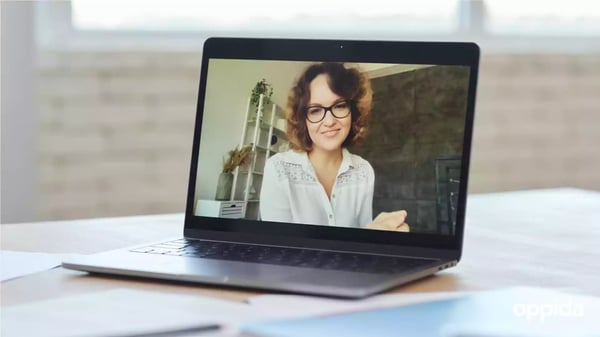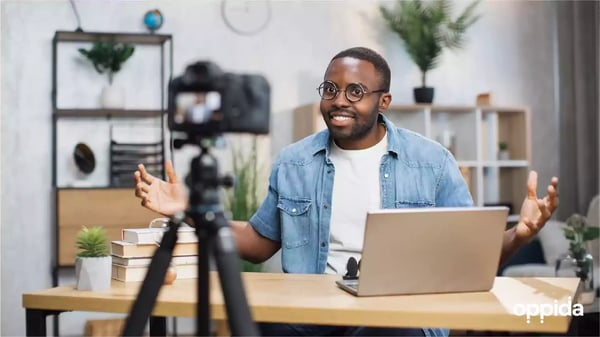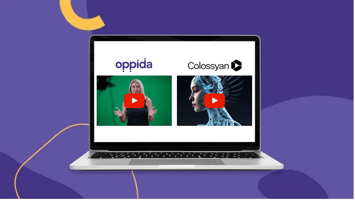In the video, 'Oppida talks: a product mindset', Bianca likens the creation of the fixed components...
Oppida talks: the use of teaching videos in online learning
In this Oppida talks video, CEO Bianca Raby discusses the best and most effective approaches to using teaching videos in online learning. Dive into the full video transcript and read more information on the topic after the video.
It’s one thing to stream a lecture live from your living room (complete with video-bombing cat) during a COVID-19 lockdown. It’s another thing altogether when you set out to create teaching video content for an online course. In that case, you’re designing specifically for the online learning experience as part of a digital education strategy. At Oppida, we’re all about ensuring that our teaching videos are effective – here’s how we do it.
The first thing is to decide whether a video is actually necessary. Check out our earlier blog: Do your online courses need video? 7 must-ask questions to help you decide to be sure that video is the right medium to teach your particular learning outcome. Then if you go ahead with the video, keep the following key points in mind.

Use audio and visuals together to present new information
Teaching videos create the opportunity to provide audio and visual material simultaneously and in an integrated way. According to the cognitive theory of multimedia learning, working memory has two channels to acquire and process new information: a visual/pictorial channel and an auditory/verbal processing channel (Mayer and Moreno, 2003). Using both channels together, and matching audio and video which complement each other enhances both information integration and retention in learners.

Keep it short
In the video above, Bianca notes that we’re designing for a 5-minute attention span. This is supported by a study of almost 7 million MOOC video viewings, which found that 5-6 minutes is the optimum length for a teaching videos (Guo, Kim and Rubin, 2014). Beyond that, viewer engagement falls off dramatically. The best idea is to segment the material into meaningful snack-size chunks by keeping the focus narrow. If there’s more material to cover, make another video. Avoid using images which don’t support the audio – they are a distraction rather than an enhancement. Use minimal music or sound effects at meaningful moments only.
Make it active and interactive
Encourage learners to actively process the information by using guiding questions and guided activity, and by allowing opportunities for reflection. Teaching videos allows learners to control the pace, stop to reflect or take action, and to repeat sections if they need to. Use tools to make it easier to navigate within the video, and signal key material through colour changes, symbols and sounds.

Make it personal and targeted
The 2014 Guo study found that students are more engaged by watching a “talking head” than by slideshows, so make sure you’re video-ready. Speak in a conversational style rather than a formal lecturing tone, and if you have to read from a script, use a teleprompter, cue cards or a tablet. Rehearse enough that your delivery flows as naturally as possible. Speak clearly and with enthusiasm directly to the camera. Make an emotional connection by telling a story rather than providing a dull narration. Define your target audience, and use verbal and text clues to indicate that the material has been designed and presented just for them.
Mix it up but don’t overload with text
Use a variety of visuals – moving images, close-ups, stills, slow-motion, and animation. Use as little text as possible, in bulleted points, and in a clear easy-to-read font. Layout should be clear and easy to follow.

Expand the learning space
Use the power of teaching videos to take learners out of the classroom on virtual tours or site visits. This doesn’t necessitate high production values, although it’s important to ensure that the image is steady (use a tripod) and the sound is clear and without wind noise. Check out our super tips for home-made/low budget teaching video production here.
We’ve summarised the material above into a free downloadable for you – help yourself here: Top ten things to consider when designing teaching videos.
References/further information
Cognitive theory and multimedia learning
- Effective Educational Videos – Vanderbilt Center for Teaching
- Applying the Science of Learning: Evidence Based Principles for the Design of Multimedia Instruction – Richard E. Mayer, University of California, Santa Barbara
- Interactive Multimodal Learning Environments – Roxana Moreno and Richard Mayer
Research and best practice
- Developing a Framework for Creating Effective Instructional Video Podcasts – RH Kay
- How Video Production Affects Student Engagement: An Empirical Study of MOOC Videos – Guo, Kim, and Ruben
- How to create Educational Videos: From watching passively to learning actively – Josef Buchner
- Developing Effective Educational Videos for Blended Learning – Moussiades, Kazanidis, and Iliopoulou
- Principles of Educational Multimedia User Interface Design – Lawrence J Najjar
- Catching the wave of video teaching: Supporting lecturers in the tourism team Inholland Diemen in developing video teaching skills – Zac Woolfitt




